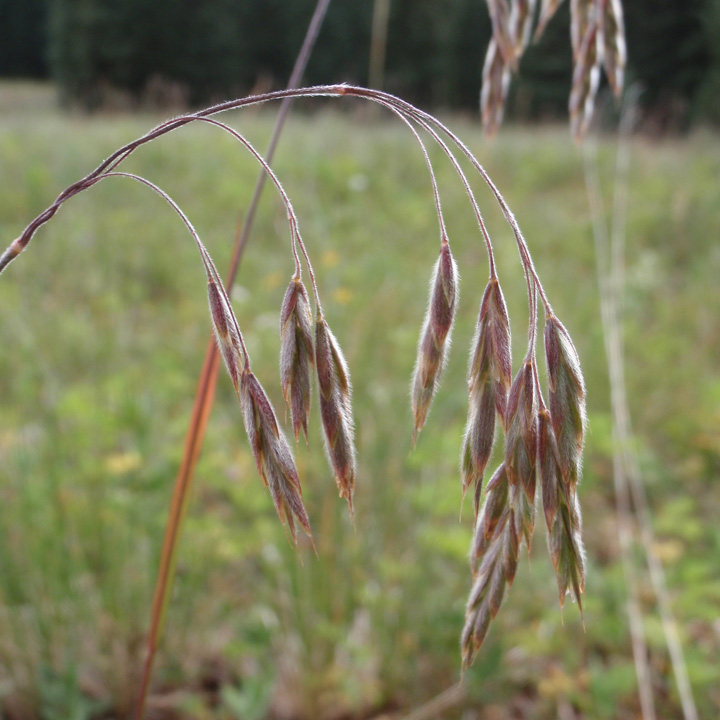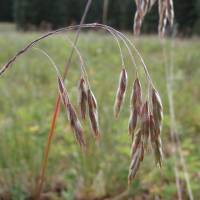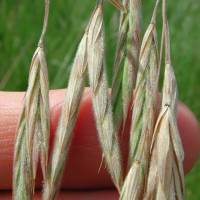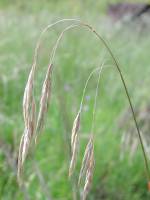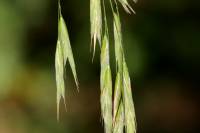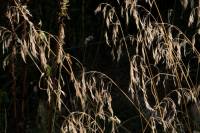Plants perennial; not rhizomatous. Culms 30-100 cm, erect; nodes (2)3-4(5), glabrous or pubescent; internodes mostly glabrous, puberulent near the nodes. Sheaths glabrous or pilose, midrib of the culm leaves not abruptly narrowed just below the collar; auricles absent; ligules to 2.5 mm, glabrous, truncate or obtuse, erose or lacerate; blades (3)10-25(35) cm long, 2-5(6) mm wide, flat, not glaucous, both surfaces usually glabrous, sometimes the adaxial surface pilose. Panicles 7-20 cm, open, nodding, often 1-sided; branches slender, ascending to spreading, often recurved and flexuous. Spikelets 12-38 mm, elliptic to lanceolate, terete to moderately laterally compressed, with (3)5-11(13) florets. Glumes usually pubescent, rarely glabrous; lower glumes 5-7(9) mm, usually 3-veined, sometimes 1-veined; upper glumes 6-10 mm, 3-veined, not mucronate; lemmas 8-14 mm, elliptic, rounded over the midvein, usually pubescent or pilose, margins often with longer hairs, backs and margins rarely glabrous, apices acute or obtuse to truncate, entire; awns (1)2-3(3.5) mm, straight, arising less than 1.5 mm below the lemma apices; anthers (1)2-3 mm. 2n = 14.
Bromus porteri grows in montane meadows, grassy slopes, mesic steppes, forest edges, and open forest habitats, at 500-3500 m. It is found from British Columbia to Manitoba, and south to California and western Texas. It is closely related to B. anomalus, and has often been included in that species. It differs chiefly in its lack of auricles, and in having culm leaves with midribs that are not narrowed just below the collar.
Common Name: Porter brome
Duration: Perennial
Nativity: Native
Lifeform: Graminoid
General: Perennial, non-rhizomatous grass, with erect stems and a nodding inflorescence; stems 30-60 cm, occasionally up to 1 m tall, glabrous in the internodes, often puberulent near the nodes.
Vegetative: Sheaths glabrous or pilose; auricles absent; ligules to 2.5 mm, glabrous, truncate or obtuse, erose or lacerate; blades 10-25 cm long, 2-5 mm wide, flat, both surfaces usually glabrous, sometimes the adaxial surface pilose.
Inflorescence: Panicles 7-20 cm, open, nodding, often 1-sided; branches slender and flexuous; spikelets 1-4 cm, terete to moderately laterally compressed, with 5-11 florets; glumes usually pubescent, lower glumes usually 3-veined, upper glumes 3-veined; lemmas 8-14 mm, rounded over the midvein, usually pubescent or pilose, margins often with longer hairs, apices entire; awns 2-3 mm, straight, arising less than 1.5 mm below the lemma apices.
Ecology: Found in montane meadows, grassy slopes, mesic steppes, forest edges, and open forest habitats, from 1,500 -11,500 ft (457-3505) m; flowers in late summer and early fall.
Distribution: Western N. Amer, from British Columbia to Manitoba, south to CA and w TX.
Notes: Following FNA, the AZ and NM material previously identified as B. anomalus (sensu Gould 1951 and Kearney and Peebles 1960) is now considered to be B. porteri. FNA considers B. anomalus to only occur in West Texas and adjacent Mexico. The two species are closely related with the only differences being that B. anomalus has glaucus culm leaves with midribs that are abruptly narrowed just below the collar, and auricles. B porteri lacks these traits. This taxon could be confused with B. catharticus, which also has short awns but is a more robust grass with larger spikelets (lemmas 11-20 mm compared to 8-14 mm in B. porteri); also similar to B. ciliatus, which has 4 mm awns and similar pubescence on the lemmas. However, B. ciliatus is a larger grass, most often about 1 m tall, and the lemmas are glabrous on the back with hairs only on the margins. In contrast, B. porteri-s lemmas have short hairs on the back, with longer hairs close to the margins. Most other similar Bromes can be distinguised by their longer awns.
Ethnobotany: Used for horse feed.
Etymology: Bromus is from Greek bromo, for stinking; porteri honors Pennsylvania botanist, poet, and classicist Thomas Conrad Porter (1822-1901).
Synonyms: Many, see Tropicos
Editor: AHazelton 2015


